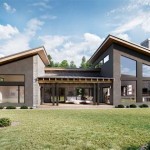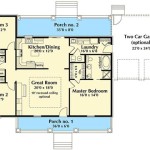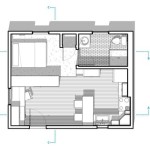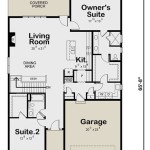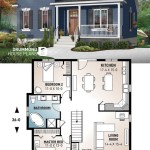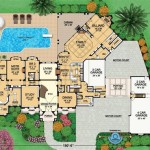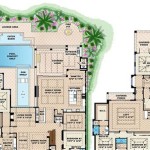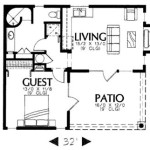Plan of a 1000 Sq Ft House: Design Considerations and Optimization
Designing a 1000 sq ft house requires careful planning and strategic space utilization to maximize functionality and comfort within the limited footprint. A well-conceived plan prioritizes efficient layout, storage solutions, and natural light to create a livable and inviting environment. This article will explore various aspects of planning a 1000 sq ft house, covering key design principles, layout options, and crucial considerations to ensure a successful project.
The initial phase involves identifying the specific needs and lifestyle of the occupants. Factors such as the number of residents, their daily routines, and preferences for privacy and shared spaces will significantly influence the design choices. Understanding these requirements is essential to create a floor plan that caters to the unique demands of the household.
Budget constraints also play a pivotal role in shaping the design. Realistic budgeting early on helps determine the level of finishes, the complexity of the construction, and the scope of any customization. It is important to prioritize essential features and consider cost-effective alternatives without compromising structural integrity or safety.
Local building codes and zoning regulations must be thoroughly investigated before finalizing the plan. These regulations dictate permissible building height, setbacks from property lines, parking requirements, and other aspects of the construction. Compliance with these codes is mandatory to obtain necessary permits and avoid legal issues during and after construction.
Maximizing Space and Functionality
One of the primary goals in designing a 1000 sq ft house is to maximize every inch of available space. This involves careful consideration of room sizes, furniture placement, and storage solutions. Open floor plans are often favored in smaller homes to create a sense of spaciousness and facilitate natural light flow.
Multifunctional spaces can significantly enhance the usability of the house. For example, a living room can double as a home office with the addition of a discreet desk and storage cabinet. Similarly, a guest bedroom can be designed as a study or hobby room when not occupied by guests. The key is to select furniture and design elements that can adapt to different functions as needed.
Vertical space is another valuable resource that should not be overlooked. Tall ceilings can create a sense of grandeur and allow for the incorporation of mezzanine levels or loft areas. Storage solutions that extend to the ceiling, such as built-in cabinets and shelving, can maximize storage capacity without encroaching on floor space.
Consider minimizing hallways and transitional areas. These spaces often serve little purpose and can consume valuable square footage. By carefully planning the layout, it is possible to create a smooth flow between rooms without the need for long corridors. Integrating circulation paths within living areas can significantly improve spatial efficiency.
The selection of furniture is crucial in a small house. Opt for pieces that are appropriately scaled to the room and serve multiple functions. For example, a sofa bed can provide seating during the day and a bed for guests at night. Ottomans with storage compartments can offer extra seating and storage space. Wall-mounted televisions can free up floor space and create a cleaner aesthetic.
Layout Options and Room Configurations
Several layout options can be adapted to a 1000 sq ft house, depending on the specific needs and preferences of the occupants. A common configuration includes two bedrooms, one bathroom, a living room, a kitchen, and a dining area. However, the size and arrangement of these rooms can be adjusted to suit individual requirements.
For a family with young children, a larger master bedroom and a smaller secondary bedroom might be preferred. Alternatively, if the house is occupied by a couple, a single, larger bedroom with a spacious walk-in closet could be a more suitable option. The bathroom size can also be adjusted based on the occupants' preferences, with options ranging from a compact shower room to a more luxurious bathroom with a bathtub.
The kitchen layout is another critical aspect of the design. A galley kitchen, with cabinets and appliances arranged along two parallel walls, is often a space-efficient option for smaller homes. Alternatively, an L-shaped kitchen can provide ample counter space and storage while maintaining an open connection to the living area. Consider incorporating a breakfast bar or island to provide additional seating and workspace.
The placement of windows and doors should be carefully considered to maximize natural light and ventilation. Orienting the house to take advantage of sunlight can significantly reduce the need for artificial lighting and heating. Large windows and sliding glass doors can connect the interior spaces to the outdoors, creating a sense of spaciousness and bringing nature indoors.
The dining area can be integrated into the living room or kitchen to save space. A small dining table with chairs can be placed near a window or in a corner of the living room. Alternatively, a breakfast bar or kitchen island can serve as a casual dining area. The key is to choose furniture that is appropriately scaled to the space and does not obstruct the flow of traffic.
Essential Design Considerations
Beyond the layout and room configurations, several other design considerations are crucial for creating a comfortable and functional 1000 sq ft house. These include proper insulation, efficient heating and cooling systems, adequate lighting, and thoughtful storage solutions.
Proper insulation is essential for maintaining a comfortable indoor temperature and reducing energy consumption. Insulating walls, ceilings, and floors can significantly reduce heat loss in the winter and heat gain in the summer. This will not only improve comfort but also lower utility bills.
Efficient heating and cooling systems are also crucial for maintaining a comfortable indoor environment. Consider installing a high-efficiency furnace or air conditioner to minimize energy consumption. A programmable thermostat can help regulate the temperature and reduce energy waste when the house is unoccupied.
Adequate lighting is essential for creating a welcoming and functional living space. Natural light should be maximized through the strategic placement of windows and skylights. Artificial lighting should be carefully planned to provide adequate illumination for different tasks and activities. Consider using energy-efficient LED lighting to reduce energy consumption.
Thoughtful storage solutions are crucial for maintaining a clutter-free and organized living space. Built-in cabinets, shelves, and drawers can provide ample storage without encroaching on floor space. Utilize vertical space by installing shelves that extend to the ceiling. Consider incorporating storage under beds and stairs to maximize space utilization.
The selection of materials and finishes can also significantly impact the look and feel of the house. Light-colored walls and ceilings can create a sense of spaciousness and reflect light more effectively. Hardwood floors or durable laminate flooring can provide a stylish and low-maintenance surface. Choose materials that are durable, easy to clean, and aesthetically pleasing.
Exterior design elements, such as landscaping and outdoor living spaces, can enhance the overall appeal and functionality of the house. A small patio or deck can provide an outdoor space for relaxing and entertaining. Landscaping can add beauty and privacy to the property. Consider planting trees and shrubs to provide shade and reduce energy consumption.
Accessibility considerations should also be taken into account, especially if the house is intended for elderly or disabled occupants. Wide doorways, ramps, and grab bars can make the house more accessible and comfortable for individuals with mobility limitations. Universal design principles can be incorporated throughout the house to ensure that it is accessible to people of all ages and abilities.
Finally, it is important to work with experienced professionals to ensure that the design and construction of the house are executed properly. Architects, builders, and interior designers can provide valuable expertise and guidance throughout the project. Their knowledge and experience can help you avoid costly mistakes and create a house that meets your needs and exceeds your expectations. By considering these various aspects of planning a 1000 sq ft house, it is possible to create a comfortable, functional, and stylish living space that maximizes every inch of available space.

Three Low Budget 1000 Sq Ft Bedroom House Plans For 120 Yard 3 Cent Plots Small Hub

Our Top 1 000 Sq Ft House Plans Houseplans Blog Com

𝟏𝟎𝟎𝟎 𝐒𝐪 𝐅𝐭 𝐇𝐨𝐮𝐬𝐞 𝐃𝐞𝐬𝐢𝐠𝐧𝐬 With Images

House Plans Under 1000 Square Feet

1000 Sq Ft House Plan N Design August 2024 Floor Plans

1000 Sqft House Plan Customized Designs By Professionals Imagination Shaper

House Plan Choosing Between 1000 Sqft And 2000 Options Green Arch World

Traditional Plan 1 000 Square Feet 2 Bedrooms Bathrooms 348 00002

2bhk Floor Plan 1000 Sqft House South Facing Houseplansdaily

1000 Square Feet Home Plans

